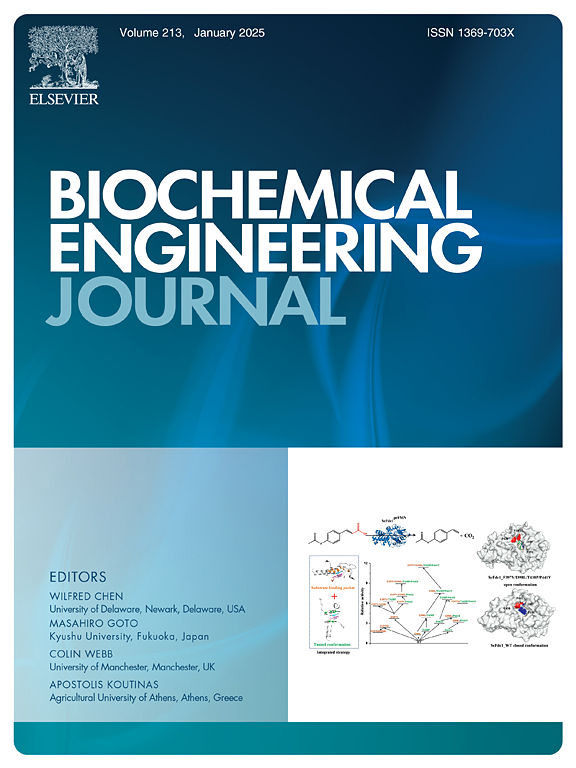Multi-purpose immobilization of lipase onto modified magnetic nanoparticles: Characterization and enhancement of enzymatic interesterification
IF 3.7
3区 生物学
Q2 BIOTECHNOLOGY & APPLIED MICROBIOLOGY
引用次数: 0
Abstract
Improving catalytic performance represents a highly desirable but challenging objective for the immobilization of biocatalysts. A novel biocatalyst of ANL@Fe3O4-SiO2-APTES was fabricated by immobilizing Aspergillus niger lipase (ANL) onto amino-alkyl group-modified magnetic nanoparticles. This biocatalyst exhibited an enzyme loading of 127.68 mg/g and the specific activity of 1132.26 U/g. The superior activity and recyclability of ANL@Fe3O4-SiO2-APTES was validated. The outstanding performance for the enzymatic interesterification (EIE) of palm stearin (PS) and rice bran oils (RBO) was observed. The significantly decreased the solid fat content (SFC) and enhanced crystallization rate of oils was achieved, as well as the β' type of oils after EIE was obtained. Moreover, molecular dynamics simulations were conducted to elucidate the underlying catalytic mechanism of EIE. This study proposes a highly efficient and sustainable approach for the chemical modification of lipids, thereby promoting its broad application in the food industry.
改良磁性纳米颗粒固定化脂肪酶的多用途研究:酶催化活性的表征和增强
提高催化性能是生物催化剂固定化的一个非常理想但具有挑战性的目标。将黑曲霉脂肪酶(ANL)固定在氨基烷基修饰的磁性纳米颗粒上制备了新型生物催化剂ANL@Fe3O4-SiO2-APTES。该生物催化剂的酶载量为127.68 mg/g,比活性为1132.26 U/g。验证了ANL@Fe3O4-SiO2-APTES具有较好的活性和可回收性。研究了棕榈硬脂脂(PS)和米糠油(RBO)的酶促酯化反应(EIE)。EIE处理后,油的固体脂肪含量(SFC)显著降低,结晶速率显著提高,并形成β′型油。此外,还进行了分子动力学模拟,以阐明eee的潜在催化机理。本研究提出了一种高效、可持续的脂类化学改性方法,从而促进其在食品工业中的广泛应用。
本文章由计算机程序翻译,如有差异,请以英文原文为准。
求助全文
约1分钟内获得全文
求助全文
来源期刊

Biochemical Engineering Journal
工程技术-工程:化工
CiteScore
7.10
自引率
5.10%
发文量
380
审稿时长
34 days
期刊介绍:
The Biochemical Engineering Journal aims to promote progress in the crucial chemical engineering aspects of the development of biological processes associated with everything from raw materials preparation to product recovery relevant to industries as diverse as medical/healthcare, industrial biotechnology, and environmental biotechnology.
The Journal welcomes full length original research papers, short communications, and review papers* in the following research fields:
Biocatalysis (enzyme or microbial) and biotransformations, including immobilized biocatalyst preparation and kinetics
Biosensors and Biodevices including biofabrication and novel fuel cell development
Bioseparations including scale-up and protein refolding/renaturation
Environmental Bioengineering including bioconversion, bioremediation, and microbial fuel cells
Bioreactor Systems including characterization, optimization and scale-up
Bioresources and Biorefinery Engineering including biomass conversion, biofuels, bioenergy, and optimization
Industrial Biotechnology including specialty chemicals, platform chemicals and neutraceuticals
Biomaterials and Tissue Engineering including bioartificial organs, cell encapsulation, and controlled release
Cell Culture Engineering (plant, animal or insect cells) including viral vectors, monoclonal antibodies, recombinant proteins, vaccines, and secondary metabolites
Cell Therapies and Stem Cells including pluripotent, mesenchymal and hematopoietic stem cells; immunotherapies; tissue-specific differentiation; and cryopreservation
Metabolic Engineering, Systems and Synthetic Biology including OMICS, bioinformatics, in silico biology, and metabolic flux analysis
Protein Engineering including enzyme engineering and directed evolution.
 求助内容:
求助内容: 应助结果提醒方式:
应助结果提醒方式:


